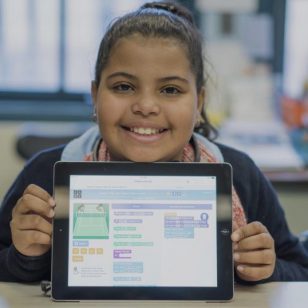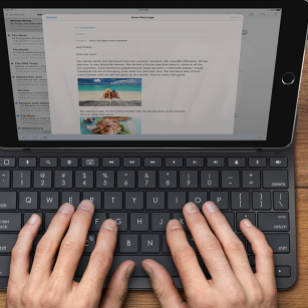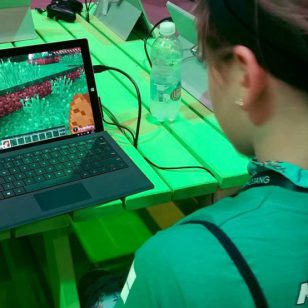My name is Beyanca Struwig. I have been teaching for the past 9 years and have seen some extraordinary changes when it comes to technology in education and I’m excited to be part of it. So much has changed over the last few years, you can only imagine what the future will expect from all of us. Not only will teachers need to be prepared for what has already become the norm, but we will also need to equip learners to compete in the global community.
Download my PowerPoint Presentation
My world is quite an exciting one. I get to change the minds of young learners and the future of education daily. It sounds like quite a big task but it’s quite simple.
My class has 38 desktops and I teach Grade 5, 6 and 7 at Buccleuch Primary School. We’re a small ‘but growing’ team of enthusiasts. We support each other in preparing foundation phase learners for the exciting possibilities that gaming holds. It is my responsibility to keep innovating and to assess how we can enhance learning in the classroom.
I would like to report on my team’s experiences and learnings.
I decided to do a survey in my classes because I need to know how their minds function currently. We cannot teach them how we think they should learn we have to cater for their growing needs or we’ll get nowhere.
I wanted to know how they study for a test and what they like to do for fun or to relax. 95% of the learner’s study by using the method that we all know, read and study the work and get someone to ask them questions. The rest preferred writing out the work, singing it etc. Then I asked them what they like to do for fun. 93% replied that they love playing games, video games, puzzle games etc. No wonder so many learners do not like studying for tests. No wonder so many of them do badly in tests.
Why can’t we combine learning with gaming?
I make use of the following tools in my class to apply concepts in gaming, teamwork and social awareness. Together the competencies learnt through gaming develop skills that my team and I have identified as being crucial in becoming productive and respectful members of society.
Minecraft Education Edition
Even though it’s not so new anymore, it still is a fantastic tool. Microsoft regularly posts updates and new possibilities are added daily. For those of you not so familiar with Minecraft, here is a quick introduction video.
My experiences of Minecraft in the classroom
- Minecraft gives learners the freedom to create, pushing their imaginations to the limit and allowing them to be creative in ways not possible in the real world.
- The game can inspire learners’ higher-level and critical thinking.
- Minecraft is also a very social game, where learners can rely on other players. When learners work together, it builds positive classroom climate, teaches the benefits of collaboration and facilitates teamwork. Learners who might not get along in the real world can become allies in the Minecraft world.
With the right imagination and creativity, teachers can implement any sort of lesson into the world of Minecraft—the possibilities are endless. You can do anything you want, limited only by your imagination.
Next up is Code.org.
Why should we teach learners code?
Technology is everywhere
Our learners were born into a digital world. Teaching code not only prepares learners for STEM careers but gives them a better understanding of machines they will interact with the rest of their lives.
Programming exercises multiple areas of the brain
A recent study found that when people work with source-code, five brain regions are activated related to language processing, working memory and attention.
More than just a science, coding enables learners to develop important personal abilities like their sense of creativity and self-expression. When developing code, learners impact the world around them while fostering problem-solving skills. Engagement soars when they see real-world connections to lessons they’re learning.
I started teaching code last year, we started with the very basics. Today my learners are creating paintings, games, e-cards etc. We have seen learners respond to the tasks in ways that we could not have predicted, those that were perceived as weak have in some instances performed best in grade. Code.org has been the best to introduce both learners and teachers to coding.
Code.org increases diversity in computer science by reaching learners of all backgrounds, skill-levels, and ages. The concepts are dressed in familiar characters and environments that inspire them to keep learning.
Flipgrid
The third-class tool I love using is called Flipgrid, where social learning happens. Flipgrid is the leading video discussion platform for millions of teachers, learners and families in over 180 countries.
What do the learners of today like to do? They love expression using social media. We leverage this to incorporate what they love into learning? I have introduced my grade 6 and 7 learners to Flipgrid. There was another instance where the most unsuspecting learner responded in a way we could not have expected. In the spirit of enhancing skills we did not want to detract from social interaction and interpersonal communication, we found that a tool life Fipgrid could break down barriers and accelerate skills development to those that were underdeveloped.
The motivation to pursue Flipgrid came from a boy in my class from years back. He struggled to communicate with teachers and feared English speech in front of a whole class. I gave him an iPad and said that he must go find a quiet spot and record his speech for me. Wow, how did that boy shine in that recording? The next time, he could sit with me where I recorded him. The third try he could do a speech in front of the whole class; the speech only lasted a few seconds but he still did it.
Ask any of my learners what they’ve learned from the games we play, and they’ll tell you without hesitation. Ask someone what they learned in 5th-grade physics, and you’ll likely just get a blank look.
Is gaming the future of education?
I believe that most certainly is, and that if you haven’t yet you should embrace it!





